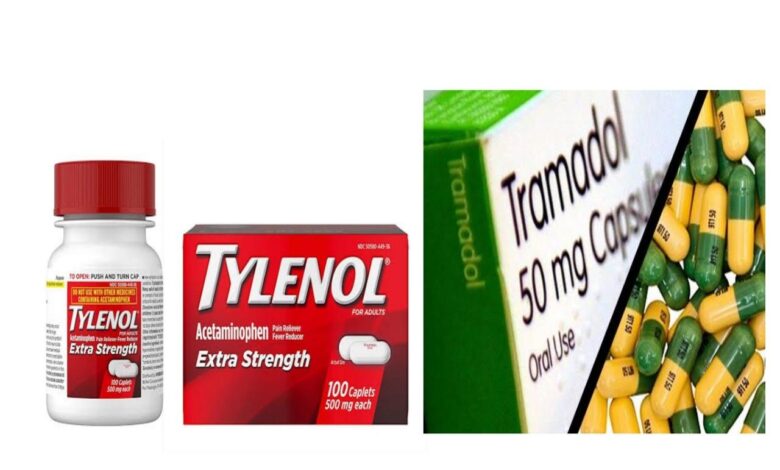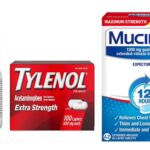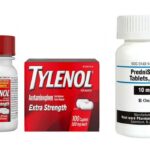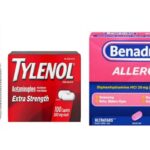Can You Take Tylenol With Tramadol?

Mixing any combination of prescription drugs, over-the-counter drugs can be unpredictable and dangerous. Most fatal overdoses involve the use of more than one type of drug (poly-drug use).
Poly-drug use is dangerous because different drugs act on our bodies in different ways. The harmful effects are magnified by using more than one drug type.
What is Tylenol?
Tylenol also known as acetaminophen is a medication that relieves mild-to-moderate pain, headache, and fever. You can use acetaminophen to relieve mild or moderate pain. This is usually pain from colds, sore throats, headaches, body or muscle aches, menstrual cramps, arthritis, or toothaches. You can also use it to reduce fever.
It’s not fully known how acetaminophen works. It doesn’t reduce swelling or inflammation. Instead, it’s thought that it blocks the release of certain chemicals in your brain that signal the sensation of pain.
What is tramadol?
Tramadol belongs to a class of drugs called opioid agonists. A class of drugs is a group of medications that work in a similar way. These drugs are often used to treat similar conditions.
Tramadol oral tablet is a prescription drug that’s available as an immediate-release and extended-release tablet. Tramadol also comes as an extended-release oral capsule. Immediate-release drugs are released into the body right away. Extended-release drugs are released into the body slowly over time.
Both tramadol oral tablets are also available as generic drugs. The immediate-release tablet is also available as the brand-name drug Ultram. Generic drugs usually cost less than the brand-name version. In some cases, they may not be available in all strengths or forms as the brand-name drug.
Tramadol is a controlled substance. This means it can only be used with a doctor’s close supervision. Tramadol is used to treat moderate to severe pain. Tramadol may be used as part of combination therapy. This means you may need to take it with other medications.
Can you take Tylenol with Tramadol together?
Yes, you can take Tylenol with Tramadol together to relieve acute pain severe enough to require opioid treatment and when other pain medicines did not work well enough or cannot be tolerated. When used together, the combination of Tylenol with Tramadol provides better pain relief than either medicine used alone.
Most combination pills contains 75 mg tramadol and 650 mg acetaminophen taken every 4 to 6 hours as needed.
Always consult with your healthcare provider prior to starting any new medication to ensure that it is safe for you given your health and medication history.
How should I take Tylenol?
Take only one product that contains acetaminophen at a time. Acetaminophen is in many products and you could accidentally take too much if you’re using more than one product at the same time. Acetaminophen can be used by all age groups in recommended doses.
Children (general): The dose of acetaminophen for children is based on body size. Usually, it is calculated as 10 mg to 15 mg per kilogram of body weight, every 4 to 6 hours. No more than 65 mg/kg should be given in a 24-hour period. Children should not take more than 5 doses in 24 hours unless advised by a doctor. For children under 6 months of age, consult a doctor.
Children’s liquid medications should be given using a calibrated dosing device, such as an oral syringe. This ensures that you are giving your child the right amount. Some formulations of liquid acetaminophen contain different concentrations of acetaminophen. Pay careful attention to the concentration on the label and the calculated dose volume.
Adults: The dose of acetaminophen for adults is 325 mg to 650 mg every 4 to 6 hours. Do not take more than 4,000 mg in a 24-hour period. If you are taking the extended-release caplets, the recommended dose for adults and children over 12 years is 1300 mg taken every 8 hours.
Acetaminophen products available without a prescription should not be used for longer than 5 days in a row for pain or 3 days in a row for fever. If you consume 3 or more alcoholic drinks in a day, do not take acetaminophen products, as your risk of liver damage is increased.
Many things can affect the dose of medication that a person needs, such as body weight, other medical conditions, and other medications. If your doctor has recommended a dose different from the ones listed here, do not change the way that you are taking the medication without talking to your doctor. Always take acetaminophen exactly as prescribed by your doctor.
How should Tramadol be used?
Tramadol comes as a tablet, a solution (liquid), an extended-release (long-acting) tablet, and an extended-release (long-acting) capsule to take by mouth. The regular tablet and solution are taken usually with or without food every 4 to 6 hours as needed. The extended-release tablet and extended-release capsule should be taken once a day. Take the extended-release tablet and the extended-release capsule at about the same time of day every day. If you are taking the extended-release capsule, you may take it with or without food. If you are taking the extended-release tablet, you should either always take it with food or always take it without food. Take tramadol exactly as directed. Do not take more medication as a single dose or take more doses per day than prescribed by your doctor. Taking more tramadol than prescribed by your doctor or in a way that is not recommended may cause serious side effects or death.
Your doctor may start you on a low dose of tramadol and gradually increase the amount of medication you take, not more often than every 3 days if you are taking the solution, regular tablets or orally disintegrating tablets or every 5 days if you are taking the extended-release tablets or extended-release capsules.
If you are taking the solution, use an oral syringe or measuring spoon or cup to measure the correct amount of liquid needed for each dose. Do not use a regular household spoon to measure your dose. Ask your doctor or pharmacist if you need help getting or using a measuring device,
Do not stop taking tramadol without talking to your doctor. Your doctor will probably decrease your dose gradually. If you suddenly stop taking tramadol, you may experience withdrawal symptoms such as nervousness; panic; sweating; difficulty falling asleep or staying asleep; runny nose, sneezing, or cough; pain; hair standing on end; chills; nausea; uncontrollable shaking of a part of your body; diarrhea; or rarely, hallucinations (seeing things or hearing voices that do not exist).





